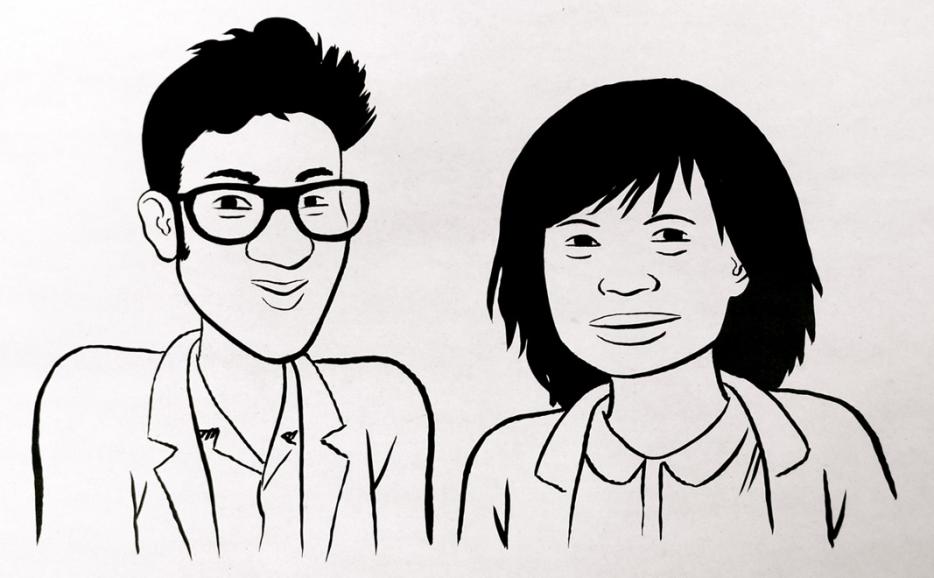Every week or so, Sook-Yin Lee and Adam Litovitz have a movie date. Then they talk about the movie. Discussed this week: Lincoln, directed by Steven Spielberg.
ADAM: We just saw a movie that inspired a guy in the audience to simulate bugle music with his mouth while he was leaving the theatre.
SOOK-YIN: Oh, yeah. I was thinking, is that flugelhorn? Wait a minute, is that a French horn? Oh! It’s bugle.
ADAM: He couldn’t simulate lachrymose strings with his mouth, so bugle.
SOOK-YIN: Lincoln, directed by Steven Spielberg. Lincoln hits the zeitgeist in 2012. We had Abraham Lincoln: Vampire Hunter and, now, just Lincoln. What’s up with that? You were pretty tuckered out at the end of a long day and we braced ourselves for two-and-a-half hours of American revisionist history.
ADAM: Let’s see how Abraham Lincoln put together the Thirteenth Amendment that changed the world.
SOOK-YIN: He abolished slavery and involuntary servitude. Sheesh, these political parties have really switched roles in the last century.
ADAM: Plus, they had oodles of different facial hairstyles for Movember.
SOOK-YIN: They pulled out all the stops on hair. In the 1800s, men were dandies. Oily on top with a burst of curls at the sides. Big choppers. Not so much the ladies, who had pulled-back Victorian styles. The movie reminded me of having to watch NFB period films in elementary school of John A. Macdonald uniting Canada.
ADAM: There was lots of cigar smoke wafting.
SOOK-YIN: For all the fabulous ‘dos, holy wrinkle-face there was very little makeup on the actors. Tommy Lee Jones had two black marbles for eyes that were moving in slits of folded, wrinkled, bag-skin. He usually gets airbrushed.
ADAM: He had the most obviously artificial hair-wig of all time: a matted black squirrel.
SOOK-YIN: That’s brave to have your big wrinkled face big on the screen.
ADAM: In the opening scene, where soldiers who’ve memorized the Emancipation Proclamation come to Lincoln, their lips are completely chapped. The filmmakers went to town making sure there was this grime.
SOOK-YIN: In the White House, it was like: who are these bag people living here? There are stains everywhere and it’s cluttered. Lincoln bleeds on the pillow and doesn’t bother to change the pillowcase.
ADAM: But that was from his gaping head wound.
SOOK-YIN: Someone could have changed the pillow.
ADAM: You don’t change pillows when you’re staging hagiographies.
SOOK-YIN: Super grimy. You could practically smell the petticoats and bad breath. At the heart of the story is this strange man, Lincoln—Daniel-Day Lewis, notorious method actor, embodying a very lanky, offbeat weirdo.
ADAM: He launches into stories at 3:40 in the morning while soldiers sleep, subtly rousing them with abstract tall-tales.
SOOK-YIN: Lincoln the one-man army is like your eccentric uncle who seems drunk, or maybe just loopy.
ADAM: He’s got a magical storytelling gift that lures people in, and sometimes weirds them out, but no one can keep their eyes off him.
SOOK-YIN: He struck me as a bit Asberger’s spectrum, with his head down in the corner, then suddenly going—boop—“let me tell you another story.” He had incredible oratory skills, but his gift was beating other people into submission by telling another story. Ronald Reagan was another president who loved to wind stories. Ronald would be like: “There was this one movie I did with a chimp. Did I tell you about Bonzo?” And Abe’s like: “Did I tell you about the time I read Euclid? I was a boy…”
ADAM: But he was a homey presence. He leaves his slippers by the fire. He’s always got his twelve-year old son Tad on his lap, reading him entomology books.
SOOK-YIN: Yeah, he’s a very good guy, and unfortunately very pussy-whipped by his wife, Mary [Sally Field]. She’s a powerful acid-tongued woman in a bell dress and corsets. She’s angry.
ADAM: Extremely vulnerable, as well. She cracks pretty easy.
SOOK-YIN: She’s cracked because of her dead son and she doesn’t want her other son to go to war. She basically tells Abe: if you do not get the Thirteenth Amendment, I will kill you.
ADAM: “Woe unto you,” she says.
SOOK-YIN: Abe is brow-beaten by a volatile wife. The two are miserable together, so what better thing to do than fight for human rights?
ADAM: Charmingly, they turn their misery into an inside joke between them: “We’re miserable, aren’t we?” Then they hug or look smilingly at each other in the carriage.
SOOK-YIN: Misery is fun. When we first see Lincoln talking to the troops, he’s sitting on the same chair as that big white statue of Lincoln sitting in a chair. Was that chair really on the war field?
ADAM: Tommy Lee Jones is Thaddeus Stevens, a strong-headed abolitionist who’s nervous about Lincoln’s wishy-washiness, because he’s spent thirty years fighting slavery. He also first appears in a…chair. He’s looking around a room full of people talking idly, and he starts in with profound rhetoric that makes them shush.
SOOK-YIN: To be a leader you need to have a chair with presence, and all that hair. Everybody started to look like Zach Galiafinakis. It was a strange group of actors: the critical darlings, Sally Field and Daniel Day-Lewis, but also the boyfriend interest in Girls as the Morse code specialist.
ADAM: James Spader pops up looking pudgy. You get to hear him huff and puff as he runs across Capitol Hill. He’s part of a group of ragtag Republican secret spies trying to convince undecided people to vote in favour of abolition. Lincoln has moments where he’s just waiting for things to happen like a dad who’s reluctant to enter the delivery room.
SOOK-YIN: He doesn’t seem to be able to pick up social cues. He tells too many stories and doesn’t notice when people are bored. It was a talky movie—talking, talking, talking, more soliloquies, more stories. The movie opens in a muddy civil war field with a graphic shot of a soldier’s face getting squashed by a boot. I thought: “here we go, Saving Private Ryan, we’re in for some big battle sequences.” But that was the only one.
ADAM: Like Saving Private Ryan, I think it started with a bleak, gritty battle to capture everyone’s attention. In Saving Private Ryan’s case, it continued to be brutal. Here you returned to little moments of a disemboweled body or two.
SOOK-YIN: Most of the story happens in rooms, with debates in nineteenth-century vernacular. Key figures were always under a spotlight. They could be anywhere—a court, a bedroom—and suddenly a face is illuminated by a circle of light. In one scene, Lincoln misses his mark and the spotlight hits his cheek. I was like, “a little to the left, Daniel.” Did you like the movie?
ADAM: I did. I was interested in spending time with these people during a crucial couple of weeks. At the same time, it conventionally built up its triumphant vibe. I was comparing it with things we’ve seen recently like Argo. Though, Argo was odious in the way it suddenly vilified its Iranian characters, making them more and more bloodthirsty toward the end. In Lincoln, you have people working towards a triumph and you have clear villains. People against the Thirteenth Amendment spit before saying “nay” to it and crumple papers angrily when people say “aye.”
SOOK-YIN: Back in 1865, they sweated and spat in hallowed halls of justice. They’re trying so hard to be civilized but they’re barbarians. There’s a tension between the cultured man and his primitivism, corseted up.
ADAM: It was a period of profound disorder—the country rift into two competing half-formed governments. Lincoln was the perfect person to wander through this world, making some kind of mystical sense of it, but unfortunately this laxity also allowed him to get plugged in the head.
SOOK-YIN: I’m curious about the zeitgeist at the time. Two years later, John A. Macdonald unified Canada. There were huge forces of dudes trying to leave their mark unifying colonized lands.
ADAM: Spielberg dramatized this by showing some people who were staunchly against slavery suddenly rising to the occasion, seeing they could be a heroic part of history. They took the long view of themselves: “I’d better not vote ‘nay,’ or I’m going to look pretty shitty in a hundred years.”
SOOK-YIN: The big vote scene added a bit of a spike to the biorhythm of the movie. They ramped up interest with the countdown formula.
ADAM: And by cutting between different faces who might care about the result.
SOOK-YIN: Mary writes down “we need 15 more votes” on her pad, which seemed very expository.
ADAM: Despite the moments of exposition, I was getting lost among a lot of the characters, names, and scenes. You had James Spader banging on a crustacean while you have to figure out what he’s trying to do.
SOOK-YIN: In 1865, you can’t just eat a crab. You have to bang it with a hammer and splatter it all over everyone’s suits.
ADAM: There was also a great moment of watching a sweaty Pennsylvanian suffering from seafood poisoning, which was second only to the seafood poisoning scene in Mike Leigh’s Topsy-Turvy.
SOOK-YIN: It was interesting to see the two sides coming together. In the final meeting between the commission from the South and Lincoln with his right-hand man, it all comes down to economics—the South worried that they were getting shafted. Lincoln freed the slaves, but he was into taxation, which back then meant tariffs on incoming and outgoing goods. The South had more international trade, which meant they’d be taxed more than the North. Some people believe that Lincoln supplanted racial slavery with economic slavery. It’s interesting to consider. What is freedom?
ADAM: Freedom is the opportunity to watch Lincoln.
SOOK-YIN: And the behind-the-scenes politicking that lead him to finally pass the Thirteenth Amendment…oh, is that a spoiler? Do people know American history?
ADAM: I think people likely know that slavery was abolished.
--
Illustration by Chester Brown





